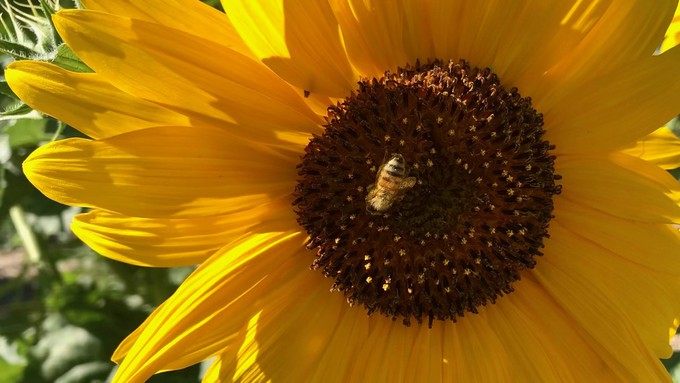
Several vegetables and flowers can be planted in late July (just remember to water)

Sunflowers planted now will provide pollen for bees into fall. Kathy Morrison
“What can I plant now?” I hear that question every week in our Sacramento community garden. For myriad reasons, a gardener has a vacant patch and wants to fill it immediately.
During midsummer in Sacramento, that list of possibilities is considerably shorter than it would be in May or June. But there are still several summer replacements that can get started now and thrive into fall.
A caveat to midsummer planting: Don’t transplant a seedling on a 106-degree day. Wait until we’re back in the mere 90s, Sacramento’s forecast for next week.
According to the National Weather Service, “very hot temperatures” are forecast through Saturday, with Valley and foothill highs ranging from 100 to 112. In Sacramento, overnight lows will be normal – low to mid 60s – and that will temper our heat. Monday’s forecast high is 93 degrees, followed by slightly below normal temperatures through at least Thursday.
That represents a window of planting opportunity. It’s still warm, but below Sacramento’s late July average of 96 degrees.
If planting (or any gardening), make the most of cool mornings; it will stay in the 70s until at least 10 a.m. It’s easier on the plants and the gardener. Keep seeds and transplants moist. Some transplants may need some temporary shade.
Flowering annuals can be transplanted now into the ground or containers for a splash of summer color. How about a pot of Barbie pink petunias or zinnias? Container gardens can be moved around (in and out of intense summer sun, for example). They brighten up any outdoor gathering. Besides petunias and zinnias, try snapdragons or marigolds.
* From seed or transplants, plant corn, pumpkins, radishes, winter squash and sunflowers. The pumpkins will be ready right around Halloween. Pumpkins are heavy feeders; enrich soil with plenty of compost. Squash and pumpkins both like to grow atop hills; plant them on a mound with a basin or moat around it to hold water. That prompts the roots to grow out. Make sure the top of the hill stays moist, too. Remember: Squash and pumpkins need room, too; they will sprawl.
Warm soil will make seeds sprout quickly, especially if presoaked. Wrap seeds in a damp paper towel for 30 minutes or longer, up to overnight. Choose varieties that take less time to mature. Regular watering is vital to get these late additions rooted and ready for heat waves to come.
Now is also time to start planning and planting for fall. Those same warm conditions are great for cool-season crops. And you don’t have to set foot outdoors.
Indoors, start seedlings for fall vegetable planting, including bunching onion, cabbage, broccoli, cauliflower, kale, radicchio and lettuce. This will keep you and the kids busy. Use recycled egg cartons or other methods. Those seedlings will be ready for transplant by Labor Day.
Seeds for several cool-season favorites can be planted in the ground now; the soil temperature will sprout them quickly. In the garden, direct-seed beets, carrots, leaf lettuce and turnips.
Got sprouted potatoes? Plant those, too. August is a great time to plant potatoes for late fall harvest.
Want more water-wise flowers? Now is a good time to sow seeds of perennials in pots including yarrow, coneflower and salvia. Once mature, they can be transplanted into the garden.
Comments
0 comments have been posted.Sacramento Digs Gardening to your inbox.
Sites We Like
Garden Checklist for week of July 21
Your garden needs you!
* Keep your vegetable garden watered, mulched and weeded. Water before 8 a.m. to reduce the chance of fungal infection and to conserve moisture.
* Feed vegetable plants bone meal, rock phosphate or other fertilizers high in phosphate to stimulate more blooms and fruiting. (But wait until daily high temperatures drop out of the 100s.)
* Don’t let tomatoes wilt or dry out completely. Give tomatoes a deep watering two to three times a week.
* Harvest vegetables promptly to encourage plants to produce more. Squash especially tends to grow rapidly in hot weather. Keep an eye on zucchini.
* Pinch back chrysanthemums for bushy plants and more flowers in September.
* Remove spent flowers from roses, daylilies and other bloomers as they finish flowering.
* Pinch off blooms from basil so the plant will grow more leaves.
* Cut back lavender after flowering to promote a second bloom.
* It's not too late to add a splash of color. Plant petunias, snapdragons, zinnias and marigolds.
* From seed, plant corn, pumpkins, radishes, winter squash and sunflowers.